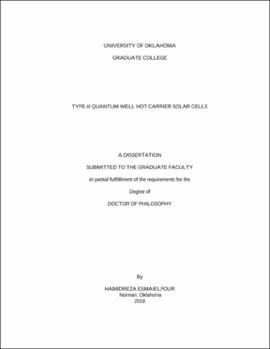| dc.contributor.advisor | Sellers, Ian R. | |
| dc.contributor.author | Esmaielpour, Hamidreza | |
| dc.date.accessioned | 2018-12-13T19:12:37Z | |
| dc.date.available | 2018-12-13T19:12:37Z | |
| dc.date.issued | 2018-12-14 | |
| dc.identifier.uri | https://hdl.handle.net/11244/316752 | |
| dc.description.abstract | Hot carrier solar cells are a third generation photovoltaic technology, which aims to increase power conversion efficiency of solar cells beyond the fundamental Shockley-Queisser limit (33%). A major source of loss in conventional solar cells is thermalization loss (heat generation), which occurs when photogenerated hot carriers lose their excess kinetic energy by interacting with phonons. Hot carrier solar cells have been proposed to reduce such thermalization losses if electron-phonon interactions can be inhibited. Despite significant recent progress in the field, there are still two significant challenges to overcome in order to design a practical hot carrier solar cell: 1) designing an efficient hot carrier absorber to inhibit hot carrier-phonon interactions; 2) develop energy selective contacts to extract hot carriers before thermalization occurs.
Here, type-II InAs/AlAsSb quantum well (QW) structures are investigated as a promising candidate for hot carrier absorbers. Continuous wave power and temperature dependent photoluminescence spectroscopy and ultrafast transient absorption spectroscopy show evidence of robust hot carrier effects at low excitation powers and room temperature, which are significant properties when designing practical hot carrier solar cells. In addition, we have investigated accurate determination of the carrier temperature and phononic properties in the QW structures to provide a better understanding and fuller picture of the nature of hot carrier effects in these systems. Furthermore, we have designed and fabricated p-i-n diodes to study the electrical properties of hot carriers within practical InAs QW structures. As a result, through determination of the origin of hot carrier thermalization processes in the system it is possible to find ways to manipulate and/or control the hot carrier loss mechanisms for hot carrier solar cell or other optoelectronic applications. Finally, we have also investigated the optical spectroscopy of 2D hybrid lead halide perovskite structures for potential hot carrier solar cells. | en_US |
| dc.language | en_US | en_US |
| dc.subject | Physics, Condensed Matter. | en_US |
| dc.subject | Photovoltaics Solar Cells | en_US |
| dc.subject | Photoluminescence Spectroscopy | en_US |
| dc.subject | Hot Carrier Effects | en_US |
| dc.title | TYPE-II QUANTUM WELL HOT CARRIER SOLAR CELLS | en_US |
| dc.contributor.committeeMember | Santos, Michael B. | |
| dc.contributor.committeeMember | Barboza, Bruno U. | |
| dc.contributor.committeeMember | Yang, Rui Q. | |
| dc.contributor.committeeMember | Abraham, Eric R. I. | |
| dc.date.manuscript | 2018-12-12 | |
| dc.thesis.degree | Ph.D. | en_US |
| ou.group | College of Arts and Sciences::Homer L. Dodge Department of Physics and Astronomy | en_US |
| shareok.orcid | 0000-0002-9432-8861 | en_US |
